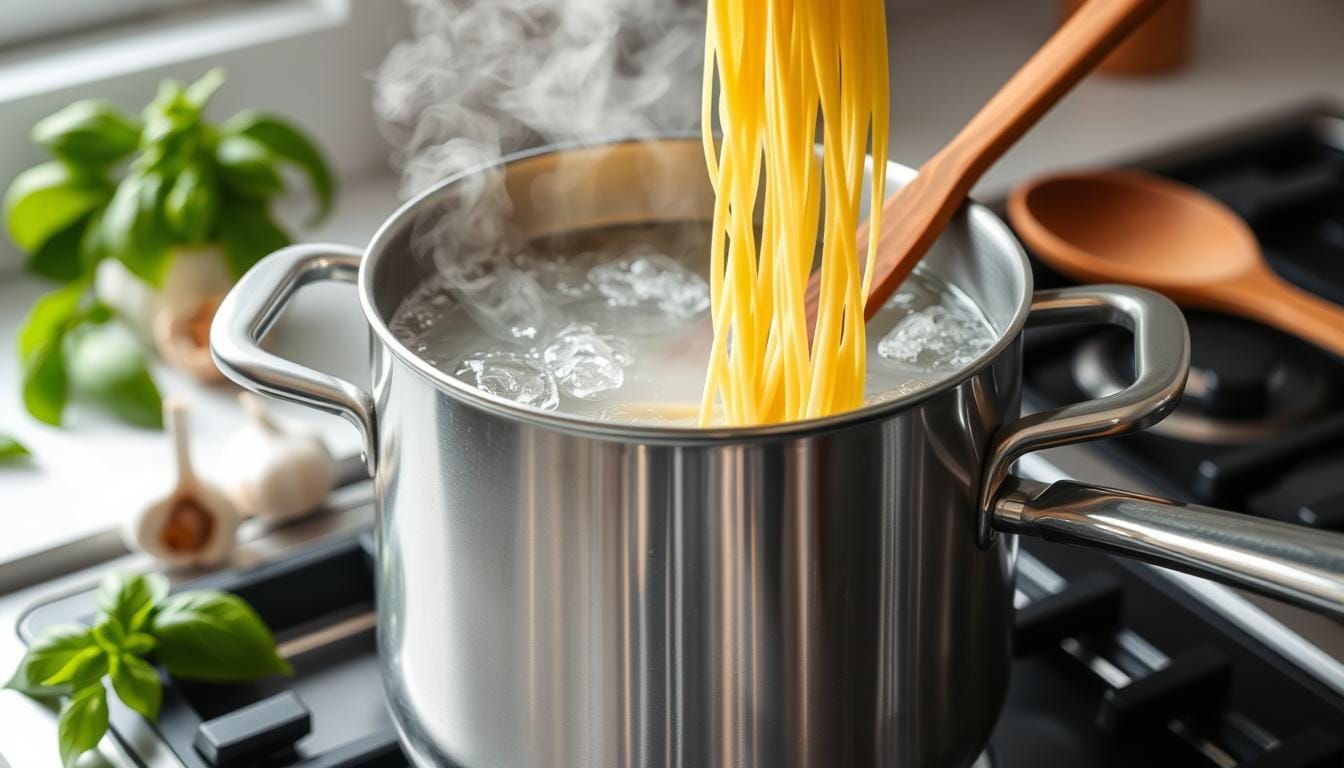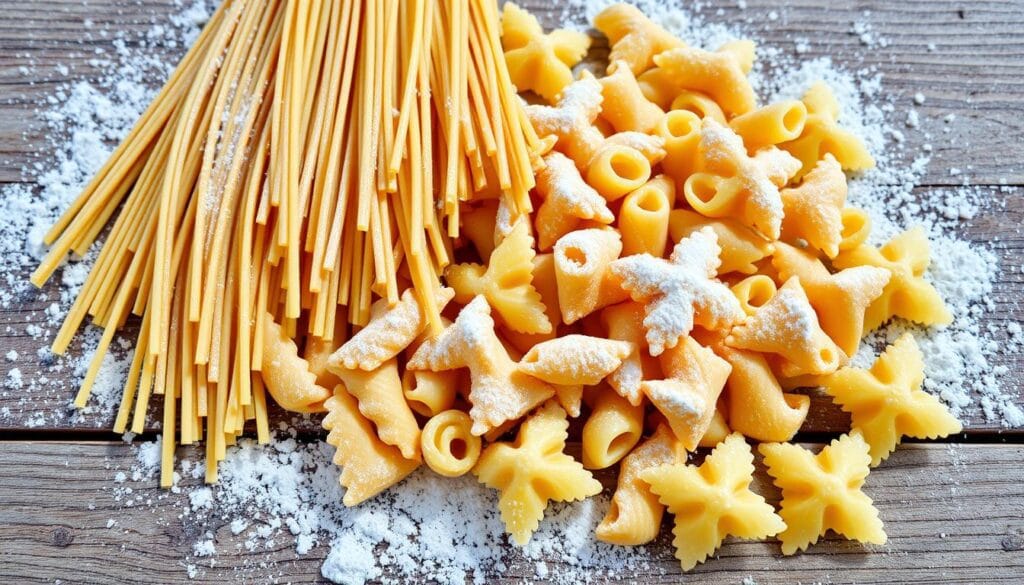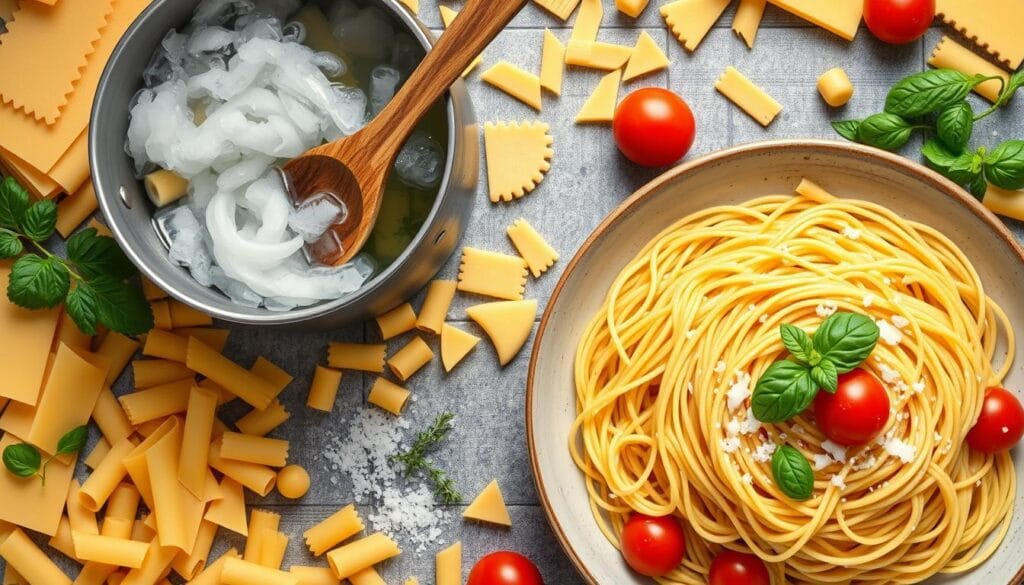I still remember the smell of homemade pasta in my grandmother’s kitchen. The al dente texture was irresistible, and her pasta cooking tips have inspired my love for perfect pasta. Now, I’m excited to share these tips to help you make perfect pasta at home.
This guide is for everyone, whether you’re a pro or just starting. You’ll learn how to make al dente pasta. From picking the right pasta to cooking it just right, you’ll get tips to impress your loved ones.
Key Takeaways
- Discover the secrets to achieving the perfect al dente texture in your pasta dishes.
- Learn how to choose the right pasta shape and type for your desired sauce and dish.
- Understand the importance of proper salting and water-to-pasta ratio for optimal cooking.
- Explore techniques for stirring, tossing, and serving your pasta to maintain its integrity.
- Discover creative ways to enhance the flavor of your pasta with herbs, broths, and more.
Understanding Different Types of Pasta
Pasta is a staple food worldwide, with many shapes, sizes, and textures. From classic spaghetti to intricate pasta shapes, each type enhances flavor and texture. Knowing the differences between dried pasta and fresh pasta helps choose the right noodle for your dish.
Common Types of Pasta Explained
The pasta world is vast, with countless shapes and varieties. Some popular pasta shapes include:
- Spaghetti: Long, thin, cylindrical noodles perfect for light, tomato-based sauces.
- Penne: Tube-shaped dried pasta with ridges that hold onto heavier, chunkier sauces.
- Linguine: Flat, long noodles similar to spaghetti, but with a slightly wider shape.
- Ravioli: Square or round fresh pasta pockets filled with a variety of delicious ingredients.
- Farfalle: Bowtie-shaped pasta shapes that add a playful touch to salads and baked dishes.
Choosing the Right Pasta for Your Dish
Choosing the perfect pasta involves considering the sauce’s texture and flavor. Lighter sauces go well with thin noodles like spaghetti or linguine. Heavier sauces suit dried pasta shapes like penne or farfalle. Fresh pasta is best for delicate, creamy sauces or fillings, thanks to its soft texture.
“The right pasta can make or break a dish. Choosing the perfect shape and texture is key to creating a harmonious, delicious meal.”
Essential Tools for Cooking Pasta
Creating delicious pasta dishes needs more than just the right ingredients. Having the right pasta cooking tools is key to getting the perfect texture and taste. Let’s look at the must-have items and why a good pot is crucial for your pasta cooking.
Must-Have Kitchen Tools
Every kitchen needs a few basic pasta cooking tools:
- A large, heavy-bottomed pot: This is vital for boiling water and cooking pasta well.
- A colander or strainer: It helps drain the cooked pasta and stops it from getting mushy.
- Tongs or forks: These tools make it easy to move the pasta from the pot to the dish without breaking it.
- A wooden spoon or spatula: Perfect for gently mixing the pasta with the sauce.
- A timer: It ensures you cook the pasta for just the right time, getting the perfect texture.
Importance of a Good Pot
The pot you use to boil water is very important. Look for a pot that is:
- Large in size: It should hold the pasta and enough water for cooking.
- Heavy-bottomed: A heavy pot keeps the water hot, even when you add the pasta.
- Made of high-quality material: Stainless steel or enameled cast iron pots are great, as they heat evenly and last long.
By choosing the right pasta cooking tools and a top-notch pot, you’ll get better at cooking perfect pasta every time.
Preparing Water for Cooking Pasta
Cooking pasta to the perfect al dente texture is more than just following package instructions. It’s about preparing the water right before adding your pasta. Let’s look at why water quantity matters and the role of salting pasta water in making a great pasta dish.
How Much Water to Use
The water-to-pasta ratio is key when cooking pasta. Use at least 4 to 6 quarts (or liters) of water for every 1 pound (or 500 grams) of pasta. This amount lets the pasta cook evenly and prevents it from sticking.
The Importance of Salt in Pasta Water
- Enhances Flavor: A generous pinch of salt in the pasta water seasons the pasta from the inside out. This makes the dish more flavorful.
- Affects Texture: Salt also makes the pasta’s exterior firmer. This leads to a better al dente texture that’s great with sauces and toppings.
- Boiling Point Increase: Adding salt raises the boiling point of the water. This lets the pasta cook at a higher temperature, making it cook faster and better.
Use about 1 to 2 tablespoons of salt per gallon (or 4 liters) of water. It might seem like a lot, but the pasta only absorbs a small part of the salt. The rest stays in the cooking water.
Understanding water quantity and salting pasta water ensures your pasta cooks perfectly every time. You’ll get a flavorful and perfectly textured result.
Cooking Time: The Key to Al Dente
Getting the perfect al dente texture in your pasta is all about mastering cooking time. The art of al dente, meaning “to the bite” in Italian, is not just a matter of personal preference. It’s a hallmark of expertly cooked pasta. By understanding the optimal cooking times for different pasta varieties, you can ensure your dishes are consistently delicious.
Understanding Cooking Times for Different Pasta
The cooking time for pasta can vary a lot depending on the type and shape. Thinner pasta varieties, such as spaghetti or angel hair, need less time to cook. Heavier, thicker pasta like rigatoni or penne takes longer. To get the best results, familiarize yourself with the recommended cooking times for the specific pasta you’re using.
- Thin pasta (spaghetti, linguine, angel hair): 7-10 minutes
- Medium pasta (penne, farfalle, fusilli): 10-12 minutes
- Thick pasta (rigatoni, bucatini, conchiglie): 12-15 minutes
Testing for Doneness
Determining when your pasta is perfectly al dente requires practice and attention. The best way to test for doneness is to start tasting the pasta a few minutes before the recommended cooking time. Take a bite and check for a firm, slightly chewy texture with a little bite to it. If the pasta is still too firm, continue cooking and testing until it reaches your desired consistency.
“The secret to perfect al dente pasta is in the timing. Taste, taste, taste – that’s the only way to know when it’s just right.”
Remember, pasta continues to cook even after you’ve drained it, so err on the side of slightly undercooked when testing for doneness. With a little practice, you’ll be able to achieve the coveted al dente texture every time. This will transform your pasta dishes into culinary masterpieces.
Mixing Techniques: Stirring and Tossing
Cooking pasta is all about how you mix and toss it. This affects the texture and taste. Learning to stir and toss is key for that perfect al dente feel and flavor.
When to Stir While Cooking
Stirring your pasta while it cooks stops it from sticking. It also makes sure it cooks evenly. Here’s when to stir:
- Stir the pasta right after adding it to boiling water to stop sticking.
- Stir every 1-2 minutes while cooking to keep heat even.
- Stir just before draining to loosen any clumped noodles.
Tossing vs. Stirring After Cooking
How you handle your pasta after cooking matters too. Tossing and stirring have different effects:
- Tossing: Tossing gently coats the noodles with sauce and keeps them separate.
- Stirring: Stirring hard can make noodles mushy. Try not to over-stir after cooking.
Using these pasta cooking tips will help you get the perfect texture and sauce distribution. Your pasta dish will taste like it’s from a restaurant.
Sauce Pairing: Matching Pasta and Sauce
Improving your pasta dishes starts with pairing the right sauce with the perfect pasta shape. Each pasta type, from thin noodles to thick ones, needs a sauce that complements it. This creates a dish with balanced flavors.
Light Sauces for Thin Pasta
Thin, delicate pasta shapes like angel hair or spaghetti go well with light, fresh sauces. Choose vibrant tomato sauces, pesto, or simple garlic and olive oil. These sauces let the pasta’s true taste shine, making the dish balanced and satisfying.
Heavier Sauces for Thick Pasta
Thicker pasta shapes like rigatoni, penne, or fusilli need richer, bolder sauces. Try creamy Alfredo, chunky meat sauces, or thick vegetable sauces. These sauces match the pasta’s texture, making the meal filling and satisfying.
| Pasta Shape | Ideal Sauce Pairing |
|---|---|
| Angel Hair, Spaghetti | Tomato, Pesto, Garlic and Olive Oil |
| Rigatoni, Penne, Fusilli | Alfredo, Meat Sauce, Vegetable Sauce |
Finding the right balance between pasta shape and sauce is key to a great pasta dish. Try different combinations to find your favorites. This will impress your guests and show off your cooking skills.
Adding Flavor: Enhancing Your Pasta
Improving your pasta dishes is easy. Two simple methods can make a big difference. Using broth instead of water and adding fresh herbs are key. These tips will help you make your pasta taste like it’s from a restaurant.
Using Broth Instead of Water
Switching to broth can add a lot of flavor to your pasta. Choose from chicken, beef, or vegetable broth. The pasta will soak up the flavors, making it taste richer and more savory. This small change can greatly enhance your pasta dishes.
Adding Fresh Herbs
- Chopped fresh basil, oregano, or parsley can brighten up any pasta dish with their vibrant, herbal notes.
- Sprinkle the herbs on top of your cooked pasta or stir them into your sauce for a truly fresh and fragrant experience.
- Experiment with different herb combinations to find your personal favorite flavor pairings.
By using these pasta cooking tips, you’ll discover a world of flavors. Adding broth and fresh herbs will make your pasta dishes even more delicious. Enjoy the simple pleasure of enhancing your pasta with these techniques.
Pasta Storage: How to Keep It Fresh
Storing pasta right is crucial for keeping it fresh and tasty. Whether it’s uncooked or leftovers, knowing how to store it makes a big difference. Let’s look at the best ways to store pasta to keep it fresh and full of flavor.
Storing Uncooked Pasta
Uncooked pasta can stay in your pantry or a cool, dry spot for a long time. Here are some easy tips to keep it fresh:
- Put uncooked pasta in an airtight container or resealable bag to stop air from getting in. This helps it stay moist and fresh.
- If the pasta comes in its original packaging, you can keep it there. Just make sure it’s tightly sealed.
- Don’t store pasta in the fridge. The moisture can cause mold and change the texture.
- For the best taste, use the pasta within 1-2 years from the packaging date.
Tips for Storing Cooked Pasta
Storing cooked pasta needs a bit more care to keep it good. Here’s how to keep your leftover pasta fresh:
- Let the cooked pasta cool down completely before storing it.
- Mix the pasta with a little oil or sauce to stop it from sticking.
- Put the pasta in an airtight container or resealable bag, squeezing out as much air as you can.
- Keep the pasta in the fridge and eat it within 3-5 days for the best taste.
- If you need to store it longer, you can freeze it for 2-3 months. Thaw it in the fridge before heating it up.
By using these easy pasta storage tips, you can enjoy fresh, tasty pasta anytime. It works for both uncooked and leftover pasta.
Common Mistakes to Avoid When Cooking Pasta
Creating tasty pasta dishes is more than just boiling water and adding noodles. To get the perfect al dente texture, you must avoid common mistakes. Learning to spot and dodge these errors will help you make better pasta and wow your guests.
Overcooking Your Pasta
One big mistake is overcooking pasta. Overcooked pasta loses its bite and becomes mushy. To avoid this, watch the cooking time closely and check the pasta texture often. When it has a slight resistance, it’s ready.
Skipping the Salt
Many people forget to season the pasta cooking water with salt. Adding salt is key because it boosts flavor and keeps the pasta firm. Salt seasons the pasta from the inside, making it more flavorful.
| Common Pasta Cooking Mistakes | How to Avoid Them |
|---|---|
| Overcooking pasta | Monitor cooking time and test the texture regularly to achieve the perfect al dente doneness. |
| Skipping the salt in the cooking water | Always add a generous pinch of salt to the pasta cooking water to enhance flavor and texture. |
By being aware of these common pasta cooking mistakes and avoiding them, you’ll make delicious pasta dishes. These dishes will impress your family and friends.
Creative Pasta Dishes: Beyond Spaghetti
Spaghetti is classic, but pasta offers many exciting shapes. From delicate angel hair to hearty rigatoni, each shape has its own charm. This makes pasta a great base for many dishes.
Exploring Unique Pasta Recipes
Move past the usual tomato sauce and meatballs. Try new things with pasta. Mix pasta shapes with pesto, alfredo, or lemon-garlic sauce for a tasty change. Use different pasta sauces in casseroles, bakes, and salads for a fun meal.
- Try a Mediterranean pasta dish with whole-wheat penne, roasted veggies, and feta dressing.
- Make mac and cheese better with small shell pasta and gourmet cheeses.
- Try Asian flavors with linguine, peanut-ginger sauce, and crunchy veggies.
Using Pasta in Salads and Casseroles
Pasta is great in salads and casseroles too. It adds a fun twist to meals. The starch in pasta balances flavors, making meals satisfying and wholesome.
| Pasta Salad Combinations | Pasta Casserole Ideas |
|---|---|
|
|
Don’t stick to just spaghetti. Explore pasta shapes and pasta sauces for new dishes. These will surprise and please your taste buds.
Serving Suggestions: How to Present Your Pasta
Presenting your pasta dishes right can make a big difference. It’s not just about cooking. Learn to plate and garnish your pasta to make it look amazing.
Plating Techniques for a Beautiful Presentation
How you arrange your pasta on the plate matters a lot. Use a wide, shallow bowl or plate to show off the pasta’s shape. Twirl the pasta neatly in the center, leaving space around it.
This makes your pasta look good and balanced. For long pasta like spaghetti, twirl it into a nest shape.
Garnishing Your Pasta Dish
Adding fresh herbs, grated cheese, and other garnishes can make your pasta dish stand out. Sprinkle chopped basil, parsley, or oregano for color and smell. Grate Parmesan or Pecorino cheese over it for extra flavor.
For a fancy touch, drizzle olive oil or sprinkle toasted breadcrumbs or nuts on top.
By learning to plate and garnish, you can make your pasta dishes look like they’re from a restaurant. It will impress your guests and improve your pasta cooking tips skills.
Frequently Asked Questions About Cooking Pasta
Starting your pasta cooking journey can raise a few questions. Don’t worry, we’ve got the answers to help you improve your pasta skills. We’ll cover gluten-free options and how to drain pasta perfectly.
Answers to Common Pasta Queries
Can I use gluten-free pasta? Yes, you can! Gluten-free pasta has improved a lot, offering tasty choices for those with dietary needs. Just remember to adjust cooking times to get the right texture.
How do I drain my pasta right? Draining pasta is key to a great dish. Use a colander to get rid of excess water. This helps your pasta soak up sauce flavors better.
Tips from Professional Chefs
Professional chefs offer great tips to enhance your pasta dishes. Chef Mario Batali suggests saving a cup of pasta water before draining. This starchy water can make your sauce thinner and creamier.
Chef Giada De Laurentiis also has a helpful tip. She says to toss cooked pasta with sauce in the pan, not just pour it over. This way, the pasta gets coated evenly and the flavors mix well.
FAQ
How much water should I use when cooking pasta?
Use at least 4-6 quarts of water for every pound of pasta. This ensures the pasta cooks well and doesn’t stick together.
Why is it important to salt the pasta water?
Salting the pasta water adds flavor to the pasta. The salt seasons the pasta from the inside, making it taste better.
What’s the difference between dried and fresh pasta?
Dried pasta is made from semolina flour and water. Fresh pasta uses eggs and all-purpose flour. Dried pasta is firmer and lasts longer, while fresh pasta is softer and doesn’t last as long.
How can I tell when my pasta is al dente?
Check for al dente by biting into a strand of pasta. It should be tender but still have a bit of chew. Don’t overcook it, as it will become mushy.
How should I toss the pasta after cooking?
After draining, toss the pasta with the sauce in the pan over medium heat. This helps the pasta soak up the sauce’s flavors evenly.
What’s the best way to store cooked pasta?
To store cooked pasta, mix it with a bit of olive oil or sauce. This prevents it from sticking. Store it in an airtight container in the fridge for 3-4 days.
Can I use gluten-free pasta in my recipes?
Yes, you can use gluten-free pasta in most recipes. Just remember it might cook differently and have a different texture.



